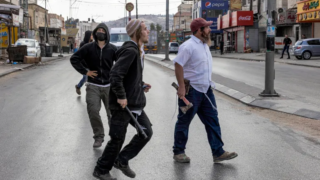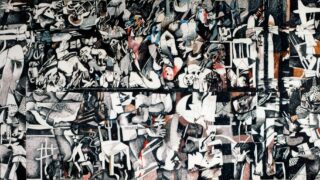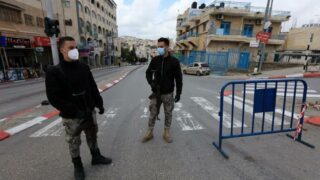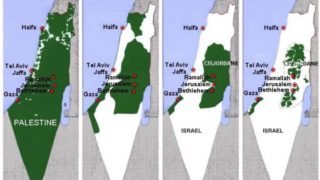Prison is a machine that manufactures suppression by applying isolation as the modus operandi and using humans as the raw material. When incarcerated, prisoners are isolated from their essential human needs and pleasures: Food and education, sex and movement, visibility and privacy, all become controlled in an extremely meticulous way by a system that strictly, and chokingly, limits time and space. Prisoners might assume free will, but their will can never be materialized as the body is usurped of its humanness through the separation of action from desire, leaving a gap that continually grows until the body becomes nothing but material.
Imagine an enormous tree being brought into a carpentry, where its most basic natural elements- roots, leaves, branches, fruits, flowers and pollen - are ripped away before it is transformed into a TV table. At the beginning, the most violent of tools are used to “process” the raw material (i.e. the biggest of saws are used to cut the tree). Then, when the product is “ready”, the need for violence dwindles and so the tools become softer (a knife or sandpaper). Just like a tree, a prisoner entering the first phase of detention – the interrogation – is subjected to the cruellest methods of isolation.
Humanness as an abyss
Israel’s General Security Service (known as “Shabak”) utilizes all the saws offered to it by the key manual for producing suppression: Israeli law. It prohibits detainees from meeting their lawyers, bans the publication of news of their arrest, extends their detention in absentia, throws them into solitary confinement, and keeps the outcomes of interrogations secret. Israeli law also exempts the Shabak from making audio-visual recordings of their interrogations of Palestinian political prisoners, thus making the interrogation room, and all the brutal torture it witnesses, a black hole irretrievably lost in space and time.
Detainees are moved around the prison blindfolded, including from their cells to the interrogation rooms. This is not just another procedure; it is in fact one of the cruelest manifestations of the modus operandi of isolation. As if it is not enough that the detention cells are built underground without windows or vents, they are also painted in a dark, fainted color that matches the brown color of the prison uniform, merging the prisoner clothes into their surroundings as if they were part of the cell, turning the detainee’s uniform into the tightest and most choking constriction on their body’s intimacy. What crueller is that the detainee is barred from the perspicuity of her/his cell as a continuity of other places. Paths create proportional relations between spaces, and when the detainee is forced to move blindfolded through the passageways inside the prison, he/she is forced to think of the cell as an absolute abyss with no way out.
During the interrogation, the main purpose of isolation is to reduce the detainee’s access to what is left of their humanness. The prison, as a machine of suppression, blocks all forms of human interaction before opening a very tight loopholes that allow for interactions that are favoured by the authorities (namely ones that lead detainees to make confessions, and therefore receive the longest possible period of detention). Colors are absent from the cells, detainees and even guards cannot rid themselves of their dark uniforms. Only one person can wear colored clothing – the interrogator – and he is the only one to offer the detainees aromatic coffee instead of the non-odorous, colorless tea they usually drink in the cells.
The isolation in the prison forms an illusion in which the detainees are persuaded that the only way to reclaim their freedom and humanness is through the interrogators. If this method does not work, the deadly silence in the cells is broken by the entrance of another detainee who brings stories from the outside world. This detainee turns out to be a spy tasked with secretly recording confessions. These methods leave detainees, who are longing to recapture whatever is left of their humanness, no other option but to plead guilty, and thus succumb to the machine of suppression. In this sense, pleading guilty is like falling into the abyss of one’s humanness.
The existentialist crisis of hunger strikes
A body that is kept in prison for years or decades is seen by the suppressor as a product that must undergo a long-term “processing phase”. The more time that passes, the more obvious the scars of suppression become, and thus the higher the “quality” of the product. A Palestinian in an Israeli prison is forbidden from carrying out what their body craves for. In fact, they are controlled to such a degree that any attempt to fulfill their bodily desires or to reclaim physical humanness is blocked. Even to eat in a manner other than what is defined by the prison wardens is forbidden. The right to learn, both naturally and academically, is also deprived (a law enacted by Israeli Supreme Court prohibits Palestinian political prisoners from pursuing academic studies). Also deprived is the right to have sexual activity (another Israeli law prohibits Palestinian prisoners from having conjugal visits with their spouses). Walls define movement; political visibility (protest) is prohibited and having a private space is blocked as prison imposes non-private social circumstances. All these factors contribute to preventing detainees from controlling their external actions.
This existentialist crisis leads prisoners to raise the idea of initiating hunger strikes. After losing control over the external, the prisoner decides to fight for their humanity by controlling what is internal: the intestines. The striker first abstains from eating, and after a period of time, their comprehension of their surroundings severely deteriorates; their ability to move is completely lost; their speech dwindles; and finally, their medical condition becomes a public concern. Thus, the prisoner robs the suppression machine of its aspired product, which fiercely aggravates the machine. In fact, it is the machine’s outrage that is most essential to the strike, rather than the hunger itself.
This is a typical manifestation of Sartre’s existentialist attitude towards absolute free choice. The binary thinking of the prisoner goes as follows: “I cannot swallow what I want (stands for food), so I will keep my digestive system empty. I can not learn what I want (education), so I will close my eyes and ears ceaselessly. My ability to move is restricted (movement), so I will not be able to move even when they want me to”. The binary opposition is very obvious when it comes to visibility and privacy: “The world cannot hear my scream of protests, so I will resort to silence. I cannot have a private space, so I will turn my medical record into an international public issue”. Mockingly, Israel’s absurd defeat clearly manifests in the well-known recurring scene of hunger strikers lying handcuffed in hospital beds unable to run away even if they wanted to.
Intestinal repression
Israel’s Force-Feeding Law, enacted few weeks ago, enables the courts to allow the force-feeding of Palestinian prisoners at the request of the Shabak and the prison authorities. A tube is passed through the detainee’s nose or mouth to reach the stomach, thereby eliminating the detainee’s participation in the eating process. This new law does not mean that Israel has not practiced force-feeding before: many hunger-striking prisoners were martyred in the past after being force-fed, including Abdelqader Abu Al-Fahm (1970) and Ali Al-Jaafari (1980).
It is easy to visualize the vicious suppression of the Israeli regime in the form of concrete walls and steel handcuffs, which helps us to understand how this predatory regime controls our bodies externally. However, in the case of force-feeding, we are confronted with a brutal scene in which the instrument of suppression is dug deep into the organs of the detainee and corrodes them internally. It is not simply a slap on the prisoner’s face, but rather an act that ruptures the tissues of the prisoner’s digestive system. The detainee, who could not retain ownership of their personal clothes during interrogation, is now deprived of ownership of their own intestines, as their body is forcefully turned into mere containers controlled by the suppression machine both externally and internally.
When I discussed the binary choices of hunger strikers, I mentioned Food, education, movement, visibility, and privacy. The only factor I did not mention is sexual activity, because the binary choice here requires an “other”. Force-feeding brings up the polar opposite of that “other”. Prison authorities prevent prisoners from acting instinctively, emotionally, and intimately, and thus the hunger strike is used to force the prison to become the polar opposite "other": Force-feeding contradicts The body’s human instincts, and the detainee’s emotions are brutally violated, by the insertion of a foreign physical object, while their privacy is completely erased by the presence of legal and medical staff as well as millions of people following the news from around the world. The detainee is thus forced to “satisfy” their bodies against their will.
All this does not happen secretly in dark narrow alleys or in the rooms of tightly secured buildings. This rape has the support of a law which was passed by the Israeli parliament with a majority of 46 to 40, ratified by the courts and overseen by political officials.
Rationalizing evil
The fact that Israel has resorted to such political and legal methods of tormenting detainees shows that the prison, as a machine of suppression, is only a small part of a larger factory of suppression known as Zionism. More importantly, the entrenchment of force-feeding into law provides Israel with a coherent structure for the practice, and thus puts it face-to-face with a crucial issue for understanding Zionism: the question of rationalism. Force-feeding is not a vindictive madness, nor a massacre done by an occupation, nor a settler crime of burning a child. Force-feeding is a very rational choice of winning and losing. Despite being one of the most dangerous, violent and possibly fatal tools for preventing Palestinians’ freedom, the use of the method is still far less risky for the prison (the machine of suppression) than losing the “product” by releasing the detainees.
Force-feeding is therefore the clearest representation of the rationalism of Zionism in general, and its military arm in particular. It is a purely behavioral and extremist form of rationalism that does not respond to any reasonable legal, humanitarian or ethical argument. It only responds to the factors of winning and losing – winning in terms of keeping Palestinians in prison as long as possible, while preserving Israel as long as possible.
This behavioral rationalism becomes more obvious when we turn to the European origins of Zionism. The two philosophers Adorno and Horkheiner associate this form of rationalism with the roots of European culture (The Odyssey in particular) as an example of losing humanness in favor of maximum efficacy of work. In seeking a social and cultural understanding of Israel, force-feeding reminds us that we are dealing with a strong, abstract and carefully designed system, which considers nothing but its winnings (Palestinian suppression) and its losses (Palestinian freedom). When Adorno and Horkheimer wrote the “Dialectic of Enlightenment” in 1944, they sought to explain the power of fascist regimes (Nazism in particular) in view of their concept of “instrumental reason”. Their explanations are no longer required, since the Israeli regime’s authoritarianism and cruelty can easily explain this criminal mentality perfectly.
(function(d, s, id) { var js, fjs = d.getElementsByTagName(s)[0]; if (d.getElementById(id)) return; js = d.createElement(s); js.id = id; js.src = "//connect.facebook.net/en_GB/sdk.js#xfbml=1&version=v2.3"; fjs.parentNode.insertBefore(js, fjs);}(document, 'script', 'facebook-jssdk'));
جريمة تعذيب واسمها التغذية القسريّة - كيف تحدث؟פשע ההזנה בכפייה - איך מתבצע העינוי?
Posted by Adalah - The Legal Center For Arab Minority Rights In Israel on Tuesday, 11 August 2015







